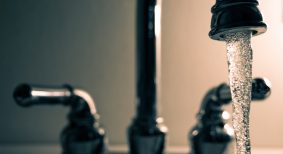The virtues of extensive vegetated roofs have been extolled for a number of years in North America. These roofs provide a reduction in the urban heat island effect, reduce cooling requirements for buildings, protect the roofing membrane, and retain, detain and filtrate stormwater to reduce the load on overloaded sewer systems and water courses. In addition, they make roofs look attractive.
However, to fulfil these functions, the plants have to be healthy and robust. This can only happen if some basic standards are adhered to.
When designing a green roof, three elements have to be optimized: drainage, growing media and plants. Together, good drainage and proper growing media create a healthy environment for site appropriate plants. Poor drainage can be a death sentence for plants. A growing medium that holds either too much or too little water, is unstable or has insufficient aeration when saturated will likewise be detrimental to plants.
The growing medium, when constituted properly, will be more than 90 per cent inorganic mineral materials such as expanded shale, slate and/or clay. Organic growing media are highly inappropriate for use on extensive green roofs. Although they will support tremendous plant growth in the first few years, after approximately five years the plants will ‘hit the wall’ and go into serious decline.
Water retention drainage layers that create a perched water table in the growing medium are also detrimental to the health of green roof plants. Likewise, water retention fleeces and filter fabrics can play havoc with drainage. Nothing should interfere with free water in the drainage layer on the way to the drain. To do so will cause permanent damage to the plants on the green roof. To avoid these problems, it’s important to think of the growing medium and plants as the primary water retention layers, not water retention cups and fabrics.
Plants used must be appropriate for a green roof. They have to be capable of surviving and thriving during all four seasons on a Canadian rooftop. The selection of those plants will depend on a number of factors. Growing media thickness is likely the first one, as it is determined by the load bearing capacity of the building. The hardiness zone of the site and height of the building will also have a large influence on plant selection.
Another factor affecting plant selection is whether the green roof will be irrigated long-term. In a shallow green roof, the selection of plants will be restricted to those that can go for extended periods without water, without going dormant. These plants are almost all plants that use Crassulacean Acid Metabolism (CAM) as their primary method of photosynthesis. Included are succulents such as Sedum, Sempervivum and Delosperma as well as Cacti. Allium and several Euphorbia are also very suitable. Depending on the hardiness zone, a broader or narrower palette will be available to select from. In deeper layers of growing media (150 to 200 millimetres), many varieties of drought tolerant perennials and grasses can be used. It should be noted, however, that unlike CAM plants, these plants are not water conservers but water seekers. To avoid summer dormancy (and sometimes death), these plants will require supplemental watering when long periods of drought occur.
Kees Govers is the technical manager for LiveRoof Ontario Inc. He has more than 25 years experience as a commercial grower of perennials and woody plants prior to becoming involved in the green roof industry.










